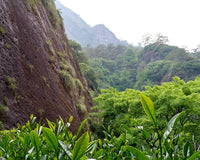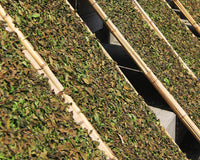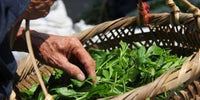The Oolong varietal Tie Guan Yin originates from AnXi county, FuJian province, Southern China. Tie Guan Yin is currently divided into three distinct types: Shu Xiang Tan Bei (熟香碳), Nong Xiang (浓香) and a light, fragrant Tie Guan Yin called Qing Xiang (清香). The former can be distinguished by a heavier, longer oxidation and roasting and are often referred to as traditional or classic Tie Guan Yin.
High quality Tie Guan Yin tea is characterised by the following:
Aroma: long lasting with hints of fruits, nuts and flowers;
Tea liquor: clear and bright;
Taste and flavour: complex layers combining sweetness and mellowness alongside floral honey notes. Balanced with a slight astringency and an enchanting finish which lingers;
Shape: tight, evenly curled, dense pellets;
Colour: depending on the style of Tie Guan Yin, the colour of the dry tea leaf pellets range from a bright, vivid, fresh green to an almost black, reddish-brown (for the traditional types). It is important that the tea is of a uniform colour;
Infused leaves: silky bright with round stalks, pliable and resilient when stretched.
Tie Guan Yin Tea Production Process
From the tea bush to a good cup of tea, Tie Guan Yin tea production is a complex series of individual steps. Each step, from plucking to packing, directly affects the quality of the final product.
1. Cai Qing (Plucking) 采青

Spring and Autumn are the two main seasons for harvesting high quality, high mountain Tie Guan Yin tea. Spring tea is typically harvested from early to mid-May and autumn tea in early October. At lower elevations, harvesting can take place all year round.
Inner Anxi's high elevations and cold temperatures result in tea bushes entering a state of hibernation during the winter. This results in spring tea containing higher levels of compounds such as polyphenols, which have a direct impact on taste and have many health benefits. The taste of spring tea is often more full-bodied than autumn tea. Autumn tea, due to the wide variation between daytime and night-time temperatures, is typically more aromatic than spring tea. Nonetheless, all high quality Tie Guan Yin teas will possess the distinctive taste and aroma characteristics which make this variety of tea so appealing and renowned.

The Pluck used for Tie Guan Yin tea is one bud and two or three leaves. The leaves are ideally harvested, depending on the prevailing weather, between 9am and 4pm. Very high quality tea leaves on optimal days are usually plucked between 9am and 2pm and are called "Wu Qing" (午青, wu meaning noon and qing meaning green). The leaves plucked before 9am are called "Zao Qing" (早青, zao, meaning morning). Tea leaves harvested when the morning dew is still on the leaves are typically of a poorer quality; the higher moisture levels impact how the plucked leaf responds to processing. Leaves plucked after 2pm are called "Wan Qing" (晚青, wan meaning evening). It can be said that Tie Guan Yin made from wan qing has less aroma than wu qing and is of a lower quality.
The choice of plucking time is impacted by the weather, state & location of the tea plant, as well as availability of labour and thus speed of plucking.
2. Shai Qing (Withering) 晒青

Withering is the step when freshly plucked tea leaves begin the active process of dehydration. Withering aims to reduce the excess water in the tea leaf whilst accelerating the oxidation process that began as soon as the leaf was plucked.
The tea leaves are laid outside in the direct sun for 20 - 50 minutes. They are usually turned two to three times. Shai Qing is best carried out between 4 and 5pm, but this depends on the temperature and strength of sunshine, humidity and leaf moisture, as well as other factors needed to regulate the speed, strength and degree of withering.
3. Liang Qing (Cooling) 晾青

This step is the cooling of the now-withered leaves. At this point, water that was stored in the stem and stalk begins spreading throughout the leaf, thus equalising the moisture content of the entire leaf. The leaves are layered at depths of no more than 100 - 150mm and turned regularly to disperse heat. The aim is to allow the leaves to cool evenly.
4. Yao Qing (Tossing) 摇青
Tossing is one of the most critical stages in the Tie Guan Yin production process. It is a mixture of withering and oxidation. Oxidation is highly important in forming the many taste and aroma compounds which give the tea its liquor, colour, strength and briskness.[2] ** Citation needed
Tossing is performed using a special bamboo drum. These drums were traditionally turned manually, but nowadays they are motorised. Tossing is conducted in three to four phases. Initially, the leaves are tossed for 10 - 15 minutes, and then 'cooled' or 'rested' for 2 hours. This is repeated a second time for 5 - 10 minutes, followed by a resting period of around 2 hours. The third phase is tossing for 15 - 20 minutes, with a cooling phase of more than 12 hours. The duration of Yao Qing and cooling are dependent on the oxidation level required.
Tossing requires skill. Tea makers are experienced at:
i. Observation: they visually monitor the shape and colour of the leaves.
Tea makers continually check the condition of the leaves by examining the veins, looking for changes in (plant/leaf) sap and other indicators, such as colour of the leaf edges.
ii. Smell: they know from smelling the leaves how and when different notes form ('grass' and 'floral', for example), and at what stage the strength is optimal and balanced.
iii. Touch: leaves that have been tossed enough should be firm to the touch with a certain degree of elasticity.
5. Sha Qing (Fixation) 杀青 (炒青)

Commonly referred to as fixation, Sha Qing means 'kill green' and is achieved by heat. During the 'kill green' process most, if not all, enzymes are denaturalised by the high temperature. This stops or slows oxidation at a chosen level.
Around 7 - 10 kg of leaves are put into a round iron pan that has been pre-heated to 220 - 250 degrees Celsius. These pans were traditionally wood-fired, but nowadays many pans are now electric or gas powered. The leaves are rapidly heated, halting oxidation, removing excess water and conditioning the leaves for shaping. The more leaves being 'fixed' in each batch, the higher the roasting temperature must be.
6. Shuai Qing 摔青

During Shuai Qing the leaves are laid out on a large square linen cloth and the four corners are gathered together so the leaves cannot fall from the bundle. The tea farmers repeatedly beat the bundle against a wall or the ground.
During this process, not only are the leaves tossed and bruised, but friction in the cloth itself causes some expulsion of additional sap and intracellular liquids from ruptures in the leaf. These 'juices' enhance the softness and stickiness of the leaves and are another important step in preparing the leaf for rolling. It is the Shuai Qing stage that causes the edge of the leaf to fray.
7. Rou Nian (Rolling) 揉捻
During the rolling phase, pressure is increased gradually. The rolling causes further ruptures in the cell walls and outer epidermis of the leaf, thereby allowing for further oxidisation and enzyme reactions.
8. Zheng Xing Bao Rou (Wrapping) 整形包揉
The tea leaves are wrapped in linen cloth bags to form large round balls. These are placed into a specially made rolling machine. The linen bags are slowly compressed as the ball is rolled between the steel plates. Guides on the rolling machine ensure the bag is constantly turning, thus rolling the leaves evenly. This process causes the leaves to slowly form into sphere-like pellets.

9. Da San (Loosening) 打散

The tightly compressed balls of tea are taken from the linen bags and broken open so that the individual leaves are freed. Loosening is important to ensure the leaves are exposed to an even temperature and a consistent amount of air. This prevents individual leaves from sticking together.
Steps 7 to 9 are repeated 20 - 40+ times until the tea leaves form into spherical pellets. The number of repetitions will depend on the condition of the leaves, the weather, the season, the required quality grade and market demand. Sometimes a farmer will deem that a looser leaf will yield better results. Traditionally, greater repetitions are reserved for higher grade teas as the additional time spent directly impacts the cost of the finished tea.
10. Bei Huo (Baking) 焙火

Baking is an intermediary step carried out during the repeated rolling stages above. Baking typically takes place two to three times, initially for around 30 minutes at 50 - 60 degrees Celsius and then subsequently, where needed, for 20 minutes at the same temperature. The tea leaves are laid out on bamboo sieves with iron stands and put into into a stove. The traditional way of baking uses charcoal. These days, many now use electric stoves which are more convenient for controlling the temperature.
11. Gan Zao (Drying) 干燥焙火
Final baking ensures the leaves are dried to the necessary moisture content and all enzymatic reactions are fully halted. The drying takes up to 3 hours at 60 degrees Celsius, depending on the condition and state of the processed leaf. The tea produced at the end of this stage is known as 'mao cha' 毛茶 and each pellet retains a stalk.
12. Picking out sticks and packing 挑梗-包装

The final step is to remove the stalks. This is often done after the tea has been sold by the farmer, or at least transported to one of the many trading towns and villages downhill from the tea gardens. Traditionally, this step is done by hand - often by immediate family members such as grandparents, children or extended family and friends, or in shops that retail the packed Tie Guan Yin.
The degree of picking and sorting will vary according to the grade of the tea. Higher grade teas may be sorted a second time, or the initial process may be more stringent with additional emphasis placed on controlling the colour and size so the tea looks uniform. During this stage, tea leaf dust is also removed and kept for other applications, such as filling tea bags.
As you can see, the production of Tie Guan Yin is very complex and time consuming. Every step mentioned above is very important in forming the tea's characteristics. A great Tie Guan Yin requires a lot of expertise, judgement and patience. It requires a lot of hard, physical labour too. During the primary tea seasons in spring and autumn, tea farmers have very little opportunity to sleep; each day's harvest merges into the following day's production.
A rule of thumb is that 2.5 kg - 3 kg of green, fresh tea leaves are needed to produce around 500 g of 'mao cha'. This yields around 300 g of finished tea. Variations will occur, depending on the quality of the original leaf, processing and the general grade.
We hope that a greater understanding of the processes involved will enhance your enjoyment of Wan Ling Tea House's range of Tie Guan Yin teas in your cup.










